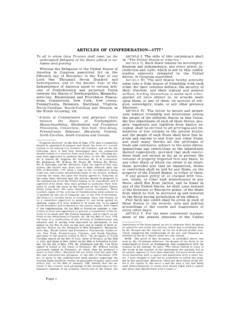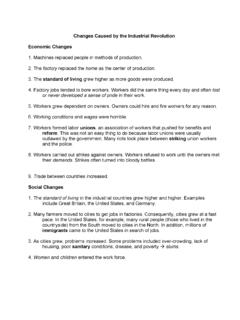Transcription of General Equilibrium - Stanford University
1 General Equilibrium Jonathan Levin . November 2006. From the time of Adam Smith's Wealth of Nations in 1776 , one re- current theme of economic analysis has been the remarkable degree of coherence among the vast numbers of individual and seemingly sepa- rate decisions about the buying and selling of commodities. In every- day, normal experience, there is something of a balance between the amounts of goods and services that some individuals want to supply and the amounts that other, di ererent individuals want to sell [sic]. Would-be buyers ordinarily count correctly on being able to carry out their intentions, and would-be sellers do not ordinarily find themselves producing great amounts of goods that they cannot sell.
2 This expe- rience of balance is indeed so widespread that it raises no intellectual disquiet among laymen; they take it so much for granted that they are not disposed to understand the mechanism by which it occurs.. Kenneth Arrow (1973). 1 Introduction General Equilibrium analysis addresses precisely how these vast numbers of indi- vidual and seemingly separate decisions referred to by Arrow aggregate in a way that coordinates productive e ort, balances supply and demand, and leads to an e cient allocation of goods and services in the economy. The answer economists have provided, beginning with Adam Smith and continuing through to Jevons and . Various sections of these notes draw heavily on lecture notes written by Felix Kubler; some of the other sections draw on Mas-Colell, Whinston and Green.
3 1. Walras is that it is the price system plays the crucial coordinating and equilibrating role: the fact the everyone in the economy faces the same prices is what generates the common information needed to coordinate disparate individual decisions. You doubtless are familiar with the standard treatment of Equilibrium in a single market. Price plays the role of equilibrating demand and supply so that all buyers who want to buy at the going price can, and do, and similarly all sellers who want to sell at the going price also can and do, with no excess or shortages on either side. The extension from this partial Equilibrium in a single market to General Equilibrium reflects the idea that it may not be legitimate to speak of Equilibrium with respect to a single commodity when supply and demand in that market depend on the prices of other goods.
4 On this view, a coherent theory of the price system and the coordination of economic activity has to consider the simultaneous General Equilibrium of all markets in the economy. This of course raises the questions of (i) whether such a General Equilibrium exists; and (ii) what are its properties. A recurring theme in General Equilibrium analysis, and economic theory more generally, has been the idea that the competitive price mechanism leads to out- comes that are e cient in a way that outcomes under other systems such as planned economies are not. The relevant notion of e ciency was formalized and tied to competitive Equilibrium by Vilfredo Pareto (1909) and Abram Bergson (1938).
5 This line of inquiry culminates in the Welfare Theorems of Arrow (1951) and De- breu (1951). These theorems state that there is in essence an equivalence between Pareto e cient outcomes and competitive price equilibria. Our goal in the next few lectures is to do some small justice to the main ideas of General Equilibrium . We'll start with the basic concepts and definitions, the welfare theorems, and the e ciency properties of Equilibrium . We'll then provide a proof that a General Equilibrium exists under certain conditions. From there, we'll investigate a few important ideas about General Equilibrium : whether Equilibrium is unique, how prices might adjust to their Equilibrium levels and whether these levels are stable, and the extent to which equilibria can be characterized and changes in exogenous preferences or endowments will have predictable consequences.
6 Finally we'll discuss how one can incorporate production into the model and then time 2. and uncertainty, leading to a brief discussion of financial markets. 2 The Walrasian Model We're going to focus initially on a pure exchange economy. An exchange economy is an economy without production. There are a finite number of agents and a finite number of commodities. Each agent is endowed with a bundle of commodities. Shortly the world will end and everyone will consume their commodities, but before this happens there will be an opportunity for trade at some set prices. We want to know whether there exist prices such that when everyone tries to trade their desired amounts at these prices, demand will just equal supply, and also what the resulting outcome will look like whether it will be e cient in a well-defined sense and how it will depend on preferences and endowments.
7 The Model Consider an economy with I agents i I = {1, .., I} and L commodities l . L = {1, .., L}. A bundle of commodities is a vector x RL+ . Each agent i has an endowment ei RL+ and a utility function ui : RL+ R. These endowments and utilities are the primitives of the exchange economy, so we write E = ((ui , ei )i I ). Agents are assumed to take as given the market prices for the goods. We won't have much to say about where these prices come from, although we'll say a bit later on. The vector of market prices is p RL+ ; all prices are nonnegative. Each agent chooses consumption to maximize her utility given her budget con- straint. Therefore, agent i solves: max ui (x) p x p ei.
8 X RL. +. The budget constraint is slightly di erent than in standard price theory. Recall that the familiar budget constraint is p x w, where w is the consumer's initial wealth. Here the consumer's wealth is p ei , the amount she could get if she sold 3. her entire endowment. We can write the budget set as Bi (p) = {x : p x p ei }. We'll occasionally use this notation below. Walrasian Equilibrium We now define a Walrasian Equilibrium for the exchange economy. A Walrasian Equilibrium is a vector of prices, and a consumption bundle for each agent, such that (i) every agent's consumption maximizes her utility given prices, and (ii). markets clear: the total demand for each commodity just equals the aggregate endowment.
9 Definition 1 A Walrasian Equilibrium for the economy E is a vector (p, (xi )i I ). such that: 1. Agents are maximizing their utilities: for all i I, xi arg max i ui (x). x B (p). 2. Markets clear: for all l L, X X. xil = eil . i I i I. Pareto Optimality The second important idea is the notion of Pareto optimality, due to the Italian economist Vilfredo Pareto. This notion doesn't have anything to do with equi- librium per se (although we'll see the close connection soon). Rather it considers the set of feasible allocations and identifies those allocations at which no consumer could be made better o without another being made worse o . P. Definition 2 An allocation (xi )i I R+ I L.
10 Is feasible if for all l L: i i I xl . P i i I el . 4. Definition 3 Given an economy E, a feasible allocation x is Pareto optimal (or Pareto e cient) if there is no other feasible allocation x such that ui (x i ) ui (xi ). for all i I with strict inequality for some i I. You should note that Pareto e ciency, while it has significant content, says essentially nothing about distributional justice or equity. For instance, it can be Pareto e cient for one guy to have everything and everyone else have nothing. Pareto e ciency just says that there aren't any win-win changes around; it's quiet on how social trade-o s should be resolved. Assumptions As we go along, we're going to repeatedly invoke a bunch of assumptions about consumers' preferences and endowments.
















